A high-resolution finite-difference method for simulating two-fluid, viscoelastic gel dynamics
- PMID: 40771873
- PMCID: PMC12326276
- DOI: 10.1016/j.jnnfm.2011.07.002
A high-resolution finite-difference method for simulating two-fluid, viscoelastic gel dynamics
Abstract
An important class of gels are those composed of a polymer network and fluid solvent. The mechanical and rheological properties of these two-fluid gels can change dramatically in response to temperature, stress, and chemical stimulus. Because of their adaptivity, these gels are important in many biological systems, e.g. gels make up the cytoplasm of cells and the mucus in the respiratory and digestive systems, and they are involved in the formation of blood clots. In this study we consider a mathematical model for gels that treats the network phase as a viscoelastic fluid with spatially and temporally varying material parameters and treats the solvent phase as a viscous Newtonian fluid. The dynamics are governed by a coupled system of time-dependent partial differential equations which consist of transport equations for the two phases, constitutive equations for the viscoelastic stresses, two coupled momentum equations for the velocity fields of the two fluids, and a volume-averaged incompressibility constraint. We present a numerical method based on a staggered grid, second order finite-difference discretization of the momentum equations and a high-resolution unsplit Godunov method for the transport equations. The momentum and incompressibility equations are solved in a coupled manner with the Generalized Minimum Residual (GMRES) method using a multigrid preconditioner based on box-relaxation. We present results on the accuracy and robustness of the method together with an illustration of the interesting behavior of this gel model for the four-roll mill problem.
Keywords: Krylov subspace; Mixture theory; Multigrid; Multiphase flow; Transient network model; Viscoelastic flow simulations.
Figures

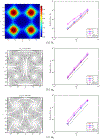
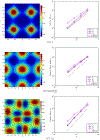
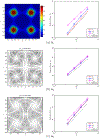
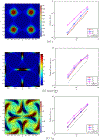

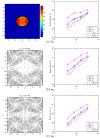
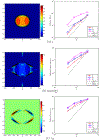
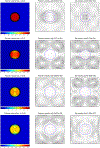
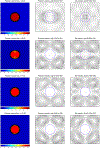

Similar articles
-
Short-Term Memory Impairment.2024 Jun 8. In: StatPearls [Internet]. Treasure Island (FL): StatPearls Publishing; 2025 Jan–. 2024 Jun 8. In: StatPearls [Internet]. Treasure Island (FL): StatPearls Publishing; 2025 Jan–. PMID: 31424720 Free Books & Documents.
-
Sexual Harassment and Prevention Training.2024 Mar 29. In: StatPearls [Internet]. Treasure Island (FL): StatPearls Publishing; 2025 Jan–. 2024 Mar 29. In: StatPearls [Internet]. Treasure Island (FL): StatPearls Publishing; 2025 Jan–. PMID: 36508513 Free Books & Documents.
-
Signs and symptoms to determine if a patient presenting in primary care or hospital outpatient settings has COVID-19.Cochrane Database Syst Rev. 2022 May 20;5(5):CD013665. doi: 10.1002/14651858.CD013665.pub3. Cochrane Database Syst Rev. 2022. PMID: 35593186 Free PMC article.
-
Fabricating mice and dementia: opening up relations in multi-species research.In: Jenkins N, Jack-Waugh A, Ritchie L, editors. Multi-Species Dementia Studies. Bristol (UK): Bristol University Press; 2025 Feb 25. Chapter 2. In: Jenkins N, Jack-Waugh A, Ritchie L, editors. Multi-Species Dementia Studies. Bristol (UK): Bristol University Press; 2025 Feb 25. Chapter 2. PMID: 40690569 Free Books & Documents. Review.
-
Systemic Inflammatory Response Syndrome.2025 Jun 20. In: StatPearls [Internet]. Treasure Island (FL): StatPearls Publishing; 2025 Jan–. 2025 Jun 20. In: StatPearls [Internet]. Treasure Island (FL): StatPearls Publishing; 2025 Jan–. PMID: 31613449 Free Books & Documents.
References
-
- Doi M, Gel dynamics, J. Phys. Soc. Jpn 78 (2009) 052001.
-
- Bird RB, Armstrong RC, Hassager O, Dynamics of Polymeric Liquids, second ed., vol. 2, Wiley, New York, 1987.
-
- Larson RG, Constitutive Equations for Polymer Melts and Solutions, Butterworth, Stoneham, MA, 1988.
-
- Gado ED, Kob W, Structure and relaxation dynamics of a colloidal gel, Europhys. Lett 72 (6) (2005) 1032. <http://stacks.iop.org/0295-5075/72/i=6|a=1032>.
Grants and funding
LinkOut - more resources
Full Text Sources
